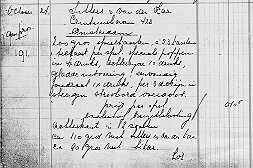
After WW I the company kept growing. In 1919 the playing card division still makes a profit, although the sales are dropping. In 1920 the turnover is even less. In 1920 the playing card tax is introduced in Holland. Decks up to 32 cards are taxed with 25cts and decks with more cards are taxed with 50 cts. The period that taxes were imposed ended in 1927. In 1924-1925 the total tax turnover increased. More than half of this amount was paid by SN. These years must have been good for SN.
But the worldwide recession is beginning to be felt here too. From 1930 to 1940 the playing card department and the printing department will not show any profit anymore. In 1934 the cardboard shop is moved to the Haarlemmer Houttuinen too. The building on the Prinseneiland is rented to a factory for vacuum cleaners.

In spite of the recession, the company still employed 78 people in 1937, of which 8 were in the playing card department (SN). In 1939 SN had a turnover of Hfl. 46.000.
From 1940 on the turnover is increasing. A large stock is present, so the company can easily supply the Dutch market in the first years. Production is soon started for the German market, as the German playing card manufacturers had to cut back on or stop their production completely.
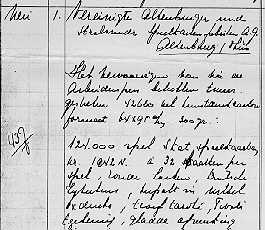
In 1942 the name of the company is changed into "Faddegon & Co. NV. (NV. meaning limited liability company).
Thanks to this export 1943 was a booming year. The turnover is Hfl. 214.000. In the later years of the war the inland market could still be supplied, but the customers were asked to deliver the carton themselves. Paper and carton were on ration and hard to get. The factory itself could get just enough carton to produce for the German market.
In 1944 there were still 80 employees, but in the last year of the war production came to a stop until May 1945.
In 1946 the "rebuilding" of Holland starts. There is a hughe demand for general goods and also for playing cards. The competitors from Germany and Belgium are not yet back in production, so there are more markets to provide for. The absolute top year for SN is 1948: the turnover increased to Hfl. 371.000. Hughes figures for those days.
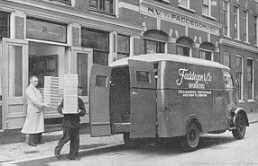
As a result the sales activities are from 1947 on conducted by a special the sales office: the office is located at the Keizersgracht 633 in Amsterdam. It is lead by mr. A.A. Haverkate. Also the company invested in a two-colour offset press, that could produce ca. 3500 sheets p/h. The last lithography press leaves the production unit: it could only produce 600 sheets (in one colour!) p/h.
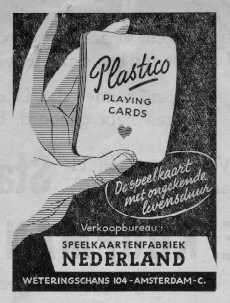
Around 1949 the foreign competition, especially from Belgium, is back and sales and turnover drop. Another problem is that the big printing orders, other then for playing cards, are given a higher priority by the management. As a result of this in 1950 the sales office could sell more than the ca 800.000 decks, that the factory can produce. In 1951 the sales office was closed. Sales were conducted directly by Faddegon again.
Until the end of the fifties, production, sales and turnover are stable. The production of playing cards covers about 20 % of the yearly turnover.
In 1959 the production of playing cards is delayed as a result of the placing of a new installation for the improvement of the backside of the playing cards. Probably this was part of a general modernization of the SN product, that also produced the new Anglo-American patterned SN-S03, with two new company jokers, as the new international card and the Belgian-Genoese patterned SN-S11 as a new card for the French and Belgian market.
In 1960 one of the two managing directors dies. R. Zegers-Veeckens had been with the company for more than 50 years.
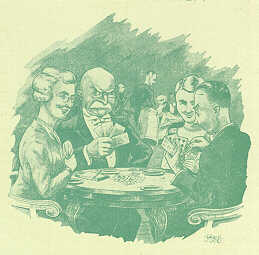 .......illustration for
a wholesale price list
.......illustration for
a wholesale price list
The decline slowly begins. Deliveries for orders from small, but regular, customers are sometimes not made in time, as big orders for other products often get priority.
At the end of the 60's the factory, located in 5 different -but connected- buildings from the 18th and 19th century, needs modernization badly. Relocating the factory elsewhere is an option, but first a general reorganization is decided.
In 1968 Faddegon murges with the Offsetcompany Augustin & Schoonman in Zwanenburg. The new name is A & S Faddegon. The last of the old directors, J.E.J. Zegers-Veeckens, resides as general director. Sales and administration are moved to Zwanenburg. Production remains in Amsterdam.
For me that is the end of it, but officially the story should end on March 23rd 1970, when the Belgian playing card manufacturer NV Van Genechten takes over the remaining playing card activities of A & S Faddegon for 1 million Belgian francs. This gives them the rights to the name of the "Speelkaartenfabriek Nederland", access to the actual customers files, the trading relations and the films for the playing card production. They were not interested in the machinery.
On March 21th 1981 a ditch is dug on a site at the Haarlemmer Houttuinen, where the Faddegon company had once been located. Archeologists will begin searching for remains of a rich past. Big lithographic stones are found, 50 to 60 years old. Some have images of playing cards on them.............